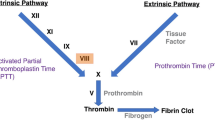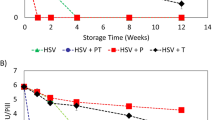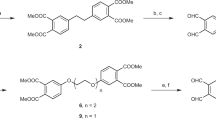Abstract
We show that extremely fragile biomolecules such as DNA restriction and modifying enzymes can be dried in vitro in the presence of trehalose with no loss of activity, even after prolonged storage. A remarkable and unexpected property of the dried enzyme preparations is their ability to withstand prolonged exposure to temperatures as high as +70°C. This stability is unique to trehalose and is not found with other sugars irrespective of their physical or chemical properties. The immediate significance of these observations is the ability to convert enzymes used in molecular biology into stable reagents. The indefinite stability and high temperature tolerance of these dried enzymes should permit the design of convenient formats that may be of particular significance in the automation of genome mapping and sequencing projects. The stabilization of a wide range of biomolecules by trehalose also has practical implications for a number of areas ranging from basic science, through healthcare and agriculture, to bio–electronics.
This is a preview of subscription content, access via your institution
Access options
Subscribe to this journal
Receive 12 print issues and online access
$209.00 per year
only $17.42 per issue
Buy this article
- Purchase on Springer Link
- Instant access to full article PDF
Prices may be subject to local taxes which are calculated during checkout
Similar content being viewed by others
References
Keilin, D. 1959. The problem of anhydrobiosis or latent life; history and current concept. Proc. Royal Soc. B150: 149–191.
Clegg, J. 1967. Metabolic studies of cryptobiosis in encysted embryos of Artemia salinov. Comp. Biochem. Physiol. 20: 801–809.
Crowe, J.H. 1971. Anhydrobiosis: An unsolved problem. Amer. Naturalist 105: 563–573.
Crowe, J.H. and Clegg, J.S. 1973. Anhydrobiosis. Dowden Hutchinson and Ross. Stroudsburg. PA.
Clegg, J.S. 1965. The origin of trehalose and its significance during the formation of encysted embryos of Artemia salinov. Comp. Biochem. Physiol. 14: 135–143.
Roth, R.J. 1970. Carbohydrate accumulation during sporulalion of yeast. J. Bacteriol. 101: 53–57.
Elbein, A.D. 1974. The metabolism of α-α trehalose. Adv. Carbohyd. Chem. Biochem. 30: 227–256.
Thevelein, J.M. 1984. Regulation of trehalose mobilization in fungi. Microbiol. Rev. 48: 42–59.
Mouradian, R., Womersley, C., Crowe, L.M. and Crowe, J.H. 1984. Preservation of functional integrity during long term storage of a biological membrane. Biochim. Biophys. Acta 778: 615–619.
Mouradian, R., Womersley, C., Crowe, L.M. and Crowe, J.H. 1985. Degradation of functional integrity during long term storage of a freeze-dried biological membrane. Cryobiol. 22: 119–124.
Carpenter, J.F. and Crowe, J.H. 1988. The mechanism of cryoprotection of proteins by solutes. Cryobiol. 25: 244–255.
Carpenter, J.F. and Crowe, J.H. 1988. Modes of stabilization of a protein by organic solutes during desiccation. Cryobiol. 25: 459–470.
Crowe, J.H., Carpenter, J.F., Crowe, L.M. and Anchordoguy, T.J. 1990. Are freezing and dehydration similar stress vectors? A comparison of modes of interaction of stabilizing solutes with biomolecules. Cryobiol. 27: 219–231.
Blakeley, D., Tolliday, B., Colaco, C.A.L.S. and Roser, B. 1990. Dry, instant blood typing plate for bedside use. The Lancet 336: 854–855.
Roser, B.J. 1991. Trehalose drying: a novel replacement for freeze-drying. Biopharm. 5: 44–53.
Crowe, J., Crowe, L., Carpenter, J.F. and Aurell Wistrom, C. 1987. Stabilization of dry phospholipid bilayers and proteins by sugars. Biochem. J. 242: 1–10.
O'Farrell, P.H., Kutter, E. and Nakanishi, M. 1980. A restriction map of the bacteriophage T4 genome. Mol. Cell. Biol. 2: 421–425.
Clegg, J.S. 1985. The physical properties and metalic status of Artemia cysts at low water contents: The “water replacement hypothesis”, p. 169–187. In: Membranes, Metabolism and Dry Organisms. Leopold, A.C. (Ed.). Cornell Univ. Press. Ithaca. NY.
Burke, M.J. 1985. The glassy stale and survival of anhydrous biological systems. p. 358–363. Ibid.
Saenger, W. 1989. Structure and dynamics of water surrounding biomolecules. Ann. Rev. Biophys. Biophys. Chem. 16: 93–114.
Otting, G., Liepinsh, E. and Wuthrich, K. 1991. Protein hydration in aqueous solution. Science 254: 974–980.
Levine, H. and Slade, L. 1988. Non-equilibrium behaviour of small carbohydrate-water systems. Pure Appl. Chem. 60: 1841–1864.
Franks, E., Hatley, R.H.M. and Mathias, S.F. 1991. Materials science and the production of shelf-stable biologicals. Biopharm. 4: 38–42.
Levine, H. and Slade, L. 1992. Another view of trehalose for drying and stabilizing biological materials. Biopharm. 5: 36–40.
Green, J.L. and Angell, C.A. 1989. Phase relations and vitrification in saccharide-water solutions and the trehalose anomaly. J. Phys. Chem. 93: 2880–2882.
Reynolds, T.H. 1965. Chemistry of non-enzymatic browning. Adv. Food Res. 14: 167–283.
Nursten, H.E. 1986. Maillard browning reactions in dried foods, p. 53–68. In: Concentration and Drying of Foods. Macarthy, D. (Ed.). Elsevier Applied Science. London.
Tewari, Y.B. and Goldberg, R.N. 1991. Thermodynamics of hydrolysis of disaccharides. Biophys. Chem. 40: 59–67.
Author information
Authors and Affiliations
Rights and permissions
About this article
Cite this article
Colaço, C., Sen, S., Thangavelu, M. et al. Extraordinary Stability of Enzymes Dried in Trehalose: Simplified Molecular Biology. Nat Biotechnol 10, 1007–1011 (1992). https://doi.org/10.1038/nbt0992-1007
Received:
Accepted:
Issue Date:
DOI: https://doi.org/10.1038/nbt0992-1007
This article is cited by
-
Glycemic, insulinemic and incretin responses after oral trehalose ingestion in healthy subjects
Nutrition Journal (2017)
-
Imprisoned lightning: charge transport in trehalose-derived sugar glasses
Ionics (2015)
-
Effect of oxidative stress on cell wall morphology in four pathogenic Candida species
Mycological Progress (2015)
-
Co-Spray Dried Carbohydrate Microparticles: Crystallisation Delay/Inhibition and Improved Aerosolization Characteristics Through the Incorporation of Hydroxypropyl-β-cyclodextrin with Amorphous Raffinose or Trehalose
Pharmaceutical Research (2015)
-
The Magic of Disaccharide Glass Matrices for Protein Function as Decoded by High-Field EPR and FTIR Spectroscopy
Applied Magnetic Resonance (2015)



